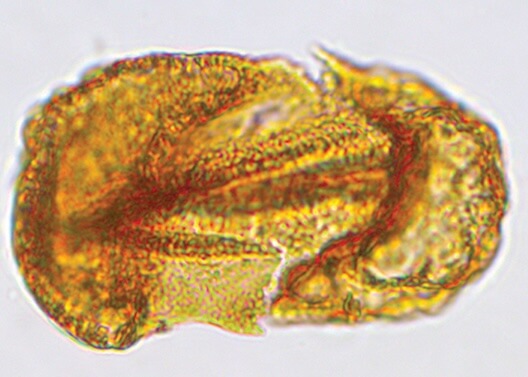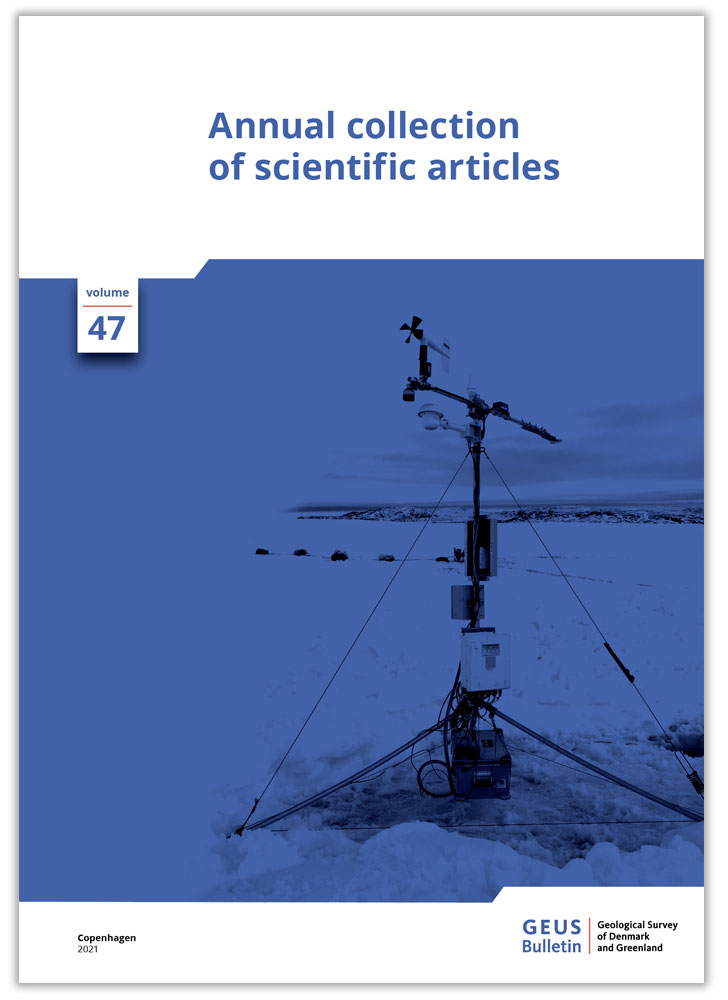
How to Cite
Share
Abstract
Permian to Triassic outcrops in East Greenland diminish significantly northwards. Understanding the northward extent, and nature, of the Permian and Triassic successions has implications for regional palaeogeographic reconstructions and exploration in adjacent offshore basins. Examining the structural relationships between the basement, Permian, Triassic, Jurassic and Cretaceous successions can further our understanding of the tectonic evolution of the region. Here, we describe a hitherto overlooked section through the Permian to Cretaceous from central Wollaston Forland and consider its structural context. The western side of Permpasset forms the upthrown eroded crest of a horst block, which provides exposure of the earliest stratigraphic intervals in the region. The fractured Caledonian basement is overlain by evaporitic marine limestone facies of the Karstryggen Formation, which are succeeded by shallow marine sandstones assigned to the Schuchert Dal Formation, both Upper Permian. The overlying unit records a period of fluvial deposition and is not possible to date. However, an Early to Middle Triassic age (Pingo Dal Group) seems most likely, given regional eustatic considerations. This is, therefore, the most northerly record of Triassic strata in North–East Greenland. West of the horst structure, fine-grained sandstones and bioturbated siltstones of the Jurassic (Oxfordian) Jakobsstigen Formation are recorded. These were downfaulted prior to a prolonged hiatus after which both the Triassic and Jurassic strata were draped by Cretaceous shales of the Fosdalen Formation. The Cretaceous succession is overlain by a thick basalt pile of Eocene age, heralding the opening of the North-East Atlantic. Glendonites overlie Oxfordian siltstones at the base of the middle Albian Fosdalen Formation. These were likely winnowed from slightly older Cretaceous strata and overlie the hiatus surface between the Jurassic and Cretaceous. This is the first record of glendonites from the Cretaceous of East Greenland and they are interpreted to record the Circum–Arctic late Aptian – early Albian cooling event.
How to Cite
Share
Copyright (c) 2021 Steven D. Andrews, Henrik Nøhr-Hansen, Pierpaolo Guarnieri, Karen Dybkjær, Sofie Lindström, Peter Alsen

This work is licensed under a Creative Commons Attribution 4.0 International License.
Funding
GEUS and MIERL joint funded the project.Downloads
An annual collection of articles submitted to GEUS Bulletin, published throughout 2021.
Cover photo: Wehrlé et al. 2022 (DOI:10.34194/geusb.v47.5284).
References
-
Andrews, S.D. & Decou, A. 2019: The Triassic of Traill Ø and Geographical Society Ø, East Greenland: Implications for North Atlantic palaeogeography. Geological Journal 54(4), 2124–2144. https://doi.org/10.1002/gj.3287
-
Andrews, S.D., Decou, A., Braham, B., Kelly, S.R.A., Robinson, P., Morton, A., Marshall, J.E.A. & Hyden, F. 2020a: Exhumed hydrocarbon traps on the North Atlantic Margin: Stratigraphy, palaeontology, provenance and bitumen distribution, an integrated approach. Basin Research 32(5), 1213–1233. https://doi.org/10.1111/bre.12424.
-
Andrews, S.D., Kelly, S.R., Braham, W. & Kaye, M. 2014: Climatic and eustatic controls on the development of a Late Triassic source rock in the Jameson Land Basin, East Greenland. Journal of the Geological Society 171(5), 609–619. https://doi.org/10.1144/jgs2013-075
-
Andrews, S.D., Morton, A.C. & Decou, A. 2020b: Mid to Late Triassic evolution of the Jameson Land Basin, East Greenland. Geological Magazine. 158(5), 930–949 https://doi.org/10.1017/S001675682000093X
-
Bjerager, M., Alsen, P., Bojesen-Koefoed, J., Fyhn, M.B., Hovikoski, J., Ineson, J., Nøhr-Hansen, H., Nielsen, L.H., Piasecki, S. & Vosgerau, H. 2020: Cretaceous lithostratigraphy of North-East Greenland. Bulletin of the Geological Society of Denmark 68, 37–93. https://doi.org/10.37570/bgsd-2020-68-04
-
Bugge, T., Ringas, J.E., Leith, D.A., Mangerud, G., Weiss, H.M. & Leith, T.L. 2002: Upper Permian as a new play model on the mid-Norwegian continental shelf: Investigated by shallow stratigraphic drilling. AAPG bulletin 86(1), 107–127. https://doi.org/10.1306/61EEDA4E-173E-11D7-8645000102C1865D
-
Christiansen, F.G., Piasecki, S., Stemmerik, L. & Telnæs, N. 1993: Depositional environment and organic geochemistry of the Upper Permian Ravnefjeld Formation source rock in East Greenland. AAPG bulletin 77(9), 1519–1537. https://doi.org/10.1306/bdff8ede-1718-11d7-8645000102c1865d
-
Clemmensen, L.B. 1980a: Triassic lithostratigraphy of East Greenland between Scoresby Sund and Kejser Franz Josephs Fjord. Bulletin Grønlands Geologiske Undersøgelse 139, 56 pp. https://doi.org/10.34194/bullggu.v139.6681
-
Clemmensen, L.B. 1980b: Triassic rift sedimentation and palaeogeography of central East Greenland. Bulletin Grønlands Geologiske Undersøgelse 136, 72 pp. https://doi.org/10.34194/bullggu.v136.6678
-
Clemmensen, L.B., Kent, D.V., Mau, M., Mateus, O. & Milàn, J. 2020: Triassic lithostratigraphy of the Jameson Land Basin (central East Greenland), with emphasis on the new Fleming Fjord Group. Bulletin of the Geological Society of Denmark 68, 95–132. https://doi.org/10.37570/bgsd-2020-68-05-rev
-
Dal Corso, J. et al. 2020: Extinction and dawn of the modern world in the Carnian (Late Triassic). Science Advances 6(38), eaba0099. https://doi.org/10.1126/sciadv.aba0099
-
Escher, J.C. 2001: Geological map of Greenland, 1:500 000, Kong Oscar Fjord, sheet 11. Copenhagen: Geological Survey of Denmark and Greenland.
-
Guarnieri, P., Brethes, A. & Rasmussen, T.M. 2017: Geometry and kinematics of the Triassic rift basin in Jameson Land (East Greenland). Tectonics 36(4), 602–614 https://doi.org/10.1002/2016tc004419
-
Haller, J. 1971: Geology of the East Greenland Caledonides, 413 pp. London: Interscience.
-
Kreiner-Møller, M. & Stemmerik, L. 2001: Upper Permian lowstand fans of the Bredehorn Member, Schuchert Dal Formation, East Greenland. In: Martinsen, O.J. & Dreyer, T. (eds): Sedimentary Environments Offshore Norway – Palaeozoic to Recent. Norwegian Petroleum Society Special Publications 10, 51–65. https://doi.org/10.1016/s0928-8937(01)80008-4
-
Maync, W. 1942: Stratigraphie und Faziesverhältnisse der oberpermiscen Ablagerungen Ostgrönlands (olim “Oberkarbon-Unterperm”) zwischen Wollaston Forland und dem Kejser Franz Josephs Fjord. Meddelelser om Grønland 115(2), 128.
-
Mueller, S., Hounslow, M.W. & Kürschner, W.M. 2016: Integrated stratigraphy and palaeoclimate history of the Carnian Pluvial Event in the Boreal realm; new data from the Upper Triassic Kapp Toscana Group in central Spitsbergen (Norway). Journal of the Geological Society 173, 186–202. https://doi.org/10.1144/jgs2015-028
-
Müller, R., Klausen, T.G., Faleide, J.I., Olaussen, S., Eide, C.H. & Suslova, A. 2019: Linking regional unconformities in the Barents Sea to compression-induced forebulge uplift at the Triassic-Jurassic transition. Tectonophysics 765, 35–51. https://doi.org/10.1016/j.tecto.2019.04.006
-
Müller, R., Nystuen, J.P., Eide, F. & Lie, H. 2005: Late Permian to Triassic basin infill history and palaeogeography of the Mid-Norwegian shelf – East Greenland region. In: Wandås et al. (eds): Onshore-Offshore Relationships on the North Atlantic margin. Norwegian Petroleum Society Special Publications 12, 165–189. https://doi.org/10.1016/S0928-8937(05)80048-7
-
Nøhr-Hansen, H. 1993: Dinoflagellate cyst stratigraphy of the Barremian to Albian, Lower Cretaceous, North-East Greenland. Bulletin Grønlands Geologiske Undersøgelse 166, 177. https://doi.org/10.34194/bullggu.v166.6722
-
Nøhr-Hansen, H., Piasecki, S. & Alsen, P. 2020: A Cretaceous dinoflagellate cyst zonation for NE Greenland. Geological Magazine 157(10), 1658–1692. https://doi.org/10.1017/s0016756819001043
-
Olsen S.D & Jakobsen K.G. 2018: Photo Flying in North East Greenland 2017. Danmarks og Grønlands Geologiske Undersøgelse Rapport 2018/14, 19 pp.
-
Paterson, N.W. & Mangerud, G. 2015: Late Triassic (Carnian–Rhaetian) palynology of Hopen, Svalbard. Review of Palaeobotany and Palynology 220, 98–119. https://doi.org/10.1016/j.revpalbo.2015.05.001
-
Paterson, N.W. & Mangerud, G. 2020: A revised palynozonation for the Middle–Upper Triassic (Anisian–Rhaetian) Series of the Norwegian Arctic. Geological Magazine 157(10), 1568–1592. https://doi.org/10.1017/s0016756819000906
-
Piasecki, S., Larsen, M., Therkelsen, J. & Vosgerau, H. 2004: Jurassic dinoflagellate cyst stratigraphy of Hold with Hope, North-East Greenland. Geological Survey of Denmark and Greenland Bulletin 5, 73–88. https://doi.org/10.34194/geusb.v5.4808
-
Poulsen, N.E., Gudmundssonn, L., Morten Hansen, J. & Husfeldt, Y. 1990. Palynological preparation techniques, a new Macerationtank-method and other modifications. Geological Survey of Denmark, Danmarks Geologiske Undersøgelse Series C 10, 23 pp. https://doi.org/10.34194/seriec.v10.7104
-
Rogov, M.A., Ershova, V.B., Shchepetova, E.V., Zakharov, V.A., Pokrovsky, B.G. & Khudoley, A.K. 2017: Earliest Cretaceous (late Berriasian) glendonites from Northeast Siberia revise the timing of initiation of transient Early Cretaceous cooling in the high latitudes. Cretaceous Research 71, 102–112. https://doi.org/10.1016/j.cretres.2016.11.011
-
Rowan, M.G. & Jarvie, A. 2020: Crustal extension and salt tectonics of the Danmarkshavn Ridge and adjacent basins, NE Greenland. Marine and Petroleum Geology 117, 104339. https://doi.org/10.1016/j.marpetgeo.2020.104339
-
Seidler, L., Steel, R., Stemmerik, L. & Surlyk, F. 2004: North Atlantic marine rifting in the Early Triassic: New evidence from East Greenland. Journal of the Geological Society 161(4), 583–592. https://doi.org/10.1144/0016-764903-063
-
Sørensen, E.V. & Dueholm, M. 2018: Analytical procedures for 3D mapping at the Photogeological Laboratory of the Geological Survey of Denmark and Greenland. Geological Survey of Denmark and Greenland Bulletin 41, 99–104. https://doi.org/10.34194/geusb.v41.4353
-
Sørensen, E.V. & Guarnieri, P. 2018: Remote geological mapping using 3D photogrammetry: An example from Karrat, West Greenland. Geological Survey of Denmark and Greenland Bulletin 41, 63–66. https://doi.org/10.34194/geusb.v41.4343
-
Stemmerik, L. 2001: Sequence stratigraphy of a low productivity carbonate platform succession: The upper Permian Wegener Halvø formation, Karstryggen area, East Greenland. Sedimentology 48(1), 79–97. https://doi.org/10.1111/j.1365-3091.2001.00352.x
-
Surlyk, F. 1990: Timing, style and sedimentary evolution of Late Palaeozoic-Mesozoic extensional basins of East Greenland. Geological Society (London) Special Publications 55(1), 107–125. https://doi.org/10.1144/gsl.sp.1990.055.01.05
-
Surlyk, F. 2003: The Jurassic of East Greenland: A sedimentary record of thermal subsidence, onset and culmination of rifting. Geological Survey of Denmark and Greenland Bulletin 1, 659–722. https://doi.org/10.34194/geusb.v1.4674
-
Surlyk, F., Hurst, J.M., Piasecki, S., Rolle, F., Scholle, P.A., Stemmerik, L. & Thomsen, E. 1986: The Permian of the western margin of the Greenland Sea – A future exploration target. In: Halbouty, M.T. (ed.): Future Petroleum Provinces of the World. AAPG Memoirs 40, 629–659. https://doi.org/10.1306/ad461791-16f7-11d7-8645000102c1865d
-
Surlyk, F. & Korstgård, J. 2013: Crestal unconformities on an exposed Jurassic tilted fault block, Wollaston Forland, East Greenland as an analogue for buried hydrocarbon traps. Marine and Petroleum Geology 44, 82–95. https://doi.org/10.1016/j.marpetgeo.2013.03.009
-
Vigran, J.O., Mangerud, G., Mørk, A., Worsley, D. & Hochuli, P.A. 2014: Palynology and geology of the Triassic succession of Svalbard and the Barents Sea. Geological Survey of Norway Special Publication 14, 269 pp.
-
Vosgerau, H., Bojesen-Koefoed, J.A., Petersen, H.I. & Surlyk, F. 2000: Forest fires, climate, and sea-level changes in a coastal plain-shallow marine succession (Early–Middle Oxfordian Jakobsstigen Formation, North-East Greenland). Journal of Sedimentary Research 70(2), 408–418. https://doi.org/10.1306/2dc40919-0e47-11d7-8643000102c1865d









